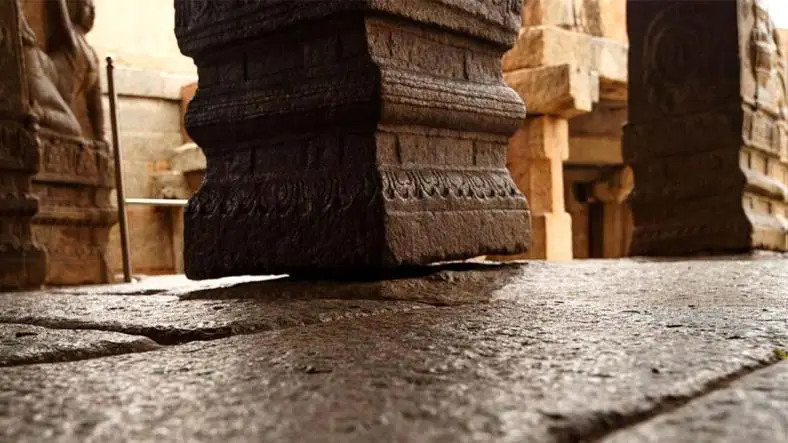Nestled in the small town of Lepakshi in Andhra Pradesh lies one of India’s most intriguing architectural enigmas—the Veerabhadra Temple, a masterpiece of the Vijayanagara period. Built in the 16th century by the brothers Viranna and Virupanna, this temple is renowned not only for its exquisite carvings and mural paintings but also for its mystifying hanging pillar—a stone column that appears to defy gravity.
This peculiar feature has baffled visitors, historians, and engineers alike for centuries. The so-called “floating” or “suspended” pillar has become the centerpiece of countless discussions on ancient Indian engineering, with some attributing it to extraordinary architectural skill, and others venturing into the realm of mystery.
The Hanging Pillar – A Marvel of Stonework
Among the temple’s 70 intricately carved stone pillars, one stands out as truly extraordinary. Unlike the others, this pillar does not rest firmly on the ground. Instead, it hangs slightly above the temple floor, leaving a small gap at its base. So pronounced is this anomaly that visitors often test it by sliding cloths, sticks, or paper beneath the stone—demonstrating that there is indeed empty space under it.
What makes it even more remarkable is that this pillar is not ornamental—it appears to form an integral part of the temple’s structural framework. Yet, despite its apparent lack of contact with the ground, the temple remains stable after nearly five centuries.
Possible Explanations for the Mystery
Scholars, architects, and engineers have long debated the secret of Lepakshi’s gravity-defying pillar. Several theories attempt to explain its existence:
1. Advanced Structural Design
Some experts argue that the pillar was deliberately crafted this way as a test of balance and load distribution. The Vijayanagara architects may have designed the temple so that the structural weight was evenly spread across the other supporting columns, allowing this particular pillar to remain slightly detached.
2. Shifting of the Foundation
Another possibility is that geological shifts or natural settling of the temple’s foundation over centuries created the illusion of the pillar being suspended. However, the precision with which it remains elevated suggests it was likely intentional, rather than accidental.
3. Experimentation in Architecture
Certain historians propose that the pillar was part of an architectural experiment, showcasing the builders’ confidence in their engineering knowledge. The suspended pillar may have served as a demonstration of their mastery, intended to astonish devotees and patrons alike.
4. Unfinished or Altered Work
Google Ad 1
There is also speculation that the pillar was either left incomplete or adjusted after damage during construction or later earthquakes. However, the perfection of the temple’s balance contradicts the idea of accidental oversight.
Legends Surrounding the Hanging Pillar
Like many Indian temples, Lepakshi is steeped in legend. According to local lore, Veerabhadra, a fierce incarnation of Lord Shiva, was enshrined here after an act of cosmic destruction. The hanging pillar is sometimes interpreted as a symbol of divine power, defying natural laws in honor of the deity.
Another story suggests that during British colonial rule, an engineer attempted to move the pillar to study its construction. In doing so, he allegedly disturbed the balance of the structure, causing portions of the ceiling to shift—prompting him to abandon the attempt. This tale, though difficult to verify, adds to the pillar’s mystique.
Beyond the Pillar – The Temple’s Grandeur
While the hanging pillar garners much attention, the Lepakshi Temple itself is an architectural treasure:
- Murals and Frescoes: The ceilings are adorned with some of the largest surviving fresco paintings of the Vijayanagara era, depicting scenes from the epics.
- Monolithic Nandi: Just outside the temple stands one of the largest monolithic Nandi statues in India, perfectly aligned with the shrine of Veerabhadra.
- Natya Mandapa (Dance Hall): A pillared hall that may have been used for performances and religious gatherings.
- Legends of Sita’s Footprint: A large footprint carved in stone is believed to be that of Goddess Sita from the Ramayana.
These features highlight that Lepakshi was not only a place of worship but also a cultural and artistic hub.
Architectural Genius or Ancient Mystery?
Whether the hanging pillar is the result of deliberate engineering brilliance or an unsolved anomaly, it reflects the profound skill of Vijayanagara artisans. The ability to carve massive granite blocks into intricately balanced structures continues to astonish modern observers.
Unlike many ancient mysteries attributed to lost technologies or supernatural explanations, the Lepakshi pillar stands as a subtle, almost playful defiance of expectation—challenging modern science to fully understand how architects of the past achieved such perfection.
Conclusion
The hanging pillar of Lepakshi Temple remains one of India’s most captivating enigmas, blending art, architecture, legend, and mystery into a single phenomenon. Five centuries on, it continues to inspire awe—whether as a demonstration of structural mastery or as a divine marvel beyond human comprehension.
For researchers, the pillar is more than just stone; it is a silent challenge left by ancient builders, reminding us that the line between science and mystery in history is often thinner than we think.
Thanks for reading the article, for more unsolved mysteries related articles read our peoples blog articles.














